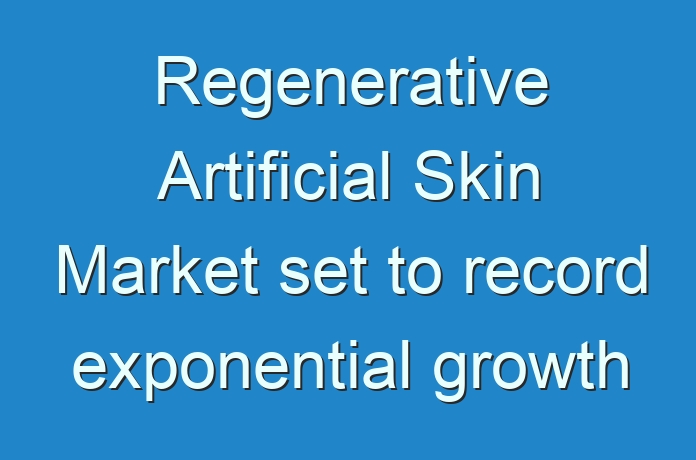
Artificial skin facilitates regeneration of skin in humans. It is a collagen scaffold. The term ‘artificial skin’ was used in the late 1970s and early 1980s to describe a new treatment for large burns. Artificial skin has been developed for commercial use under the name Integra. It is used in burned patients for the treatment of chronic skin wounds and during plastic surgery of the skin.
Read Report Overview: https://www.transparencymarketresearch.com/regenerative-artificial-skin-marke.html
The trend in the treatment of burn wounds is gradually shifting to more holistic approach in the long term. Approaches are more focused on improvement of quality of life. Different types of skin substitutes are used for the management of acute and chronic burns. Skin substitutes play an important roles in the treatment of full thickness wounds and deep dermal wounds of different aetilogies. Usually, artificial skins are developed with the help of collagen, which is absorbed by the human body without difficulty. Artificial skin facilitates the generation of new skin in the affected area. According to an American Burn Association report, in 2016, approximately 487,000 people underwent medical treatment for minor burns, while around 72,000 people were hospitalized for major skin burn injuries.
The global regenerative artificial skin market is expected to expand at a rapid pace in the next few years. Increase in incidence of traumas and fatal & severe skin injuries is a major factor driving the global regenerative artificial skin market. Many patients suffering from traumas and fatal & severe skin injuries may require surgical procedures to restore their skin. Requirement of surgical skin procedures depends on the extent of burns. Artificial skin graft is one of the successful treatments available in many cases with third degree burns, wherein there is very little or intact skin left. Artificial skin protects and covers the wound. This helps promote the restoration of natural skin. Currently, many skin repair products & treatments are commonly used to heal the injured part. These include Hyalomatrix, OrCel, Matriderm, Integra, Dermagraft, Apligraft, Biobrane, Composite and Renoskin Cultured Skin. Most companies operating in the regenerative artificial skin market invest significantly in research and development activities. For instance, Avita Medical is trying to develop an autologous spray Recell.
Looking for a complete analysis of competitive dynamics? , Get the PDF Sample Copy of this report: https://www.transparencymarketresearch.com/sample/sample.php?flag=S&rep_id=63363
On the other hand, high cost associated with surgeries & drug delivery; overall skin treatment; and side effects associated with it are expected to hamper the market in the near future. Lack of awareness of products and services offered, inadequate medical infrastructure, and low access to medical facilities in developing countries are expected to hinder the market.
The global regenerative artificial skin market can be segmented based on material type and end-user. In terms of material type, the market can be segregated into composite skin material, permanent skin material, and temporary skin material. Effects of each product lasts between months to years, depending upon class, type, and quantity of material required to inject. For instance, permanent type skin material is usually used in dermal & epidermal skin materials. In terms of end-user, the global regenerative artificial skin market can be segregated into clinics, hospitals, and others.
Based on region, the global regenerative artificial skin market can be classified into Asia Pacific, North America, Europe, Latin America, and Middle East & Africa. North America is expected to dominate the market in the near future. The market in Europe and Asia Pacific is estimated to be driven by the rise in awareness among the people about the usage of skin and health care products. The regenerative artificial skin market in Asia Pacific is projected to expand at a rapid pace during the forecast period. It is expected to be one of the highly lucrative regions of the market. This can be ascribed to the increase in number of people opting for cosmetic procedures, rise in incidences of accidental burns, and growth in number of people opting for plastic surgeries due to the rise in per capita income. Additionally, rise in number of skin diseases, increase in rate of acid attacks in rural areas, and growth in number of industrial accidents leading to fire and injuries are some of the other factors contributing to the market growth.
To Get Detailed Overview about the global market report (COVID-19 Impact Analysis): https://www.transparencymarketresearch.com/sample/sample.php?flag=covid19&rep_id=63363
Key players operating in the global regenerative artificial skin market are Smith & Nephew, Johnson & Johnson, Mallinckrodt Plc, Mylan N.V., and Integra Life Sciences Corporation.
Contact
Transparency Market Research,
90 State Street, Suite 700,
Albany, NY 12207
Tel: +1-518-618-1030
USA – Canada Toll Free: 866-552-3453
Email: sales@transparencymarketresearch.com





